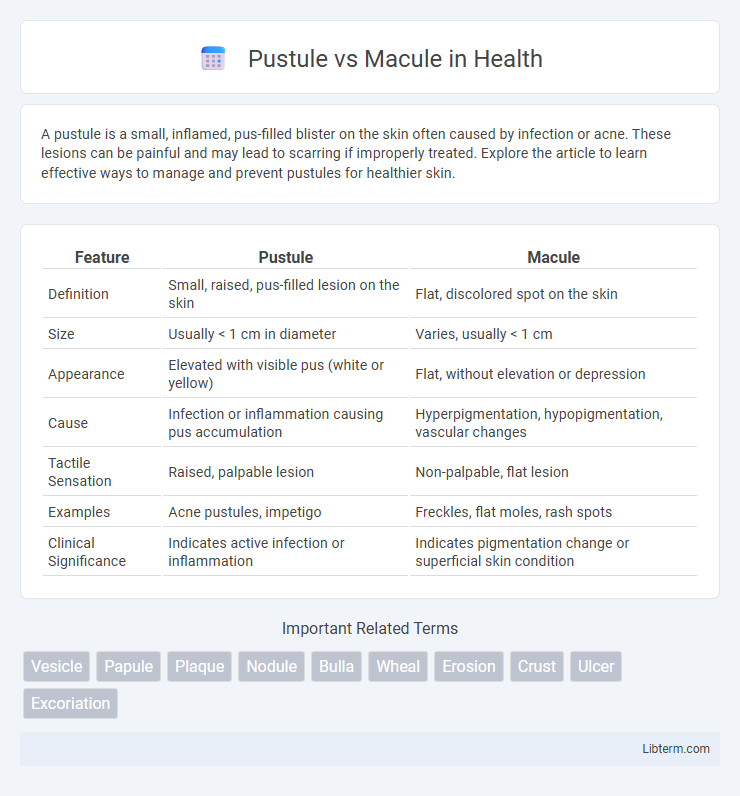A pustule is a small, inflamed, pus-filled blister on the skin often caused by infection or acne. These lesions can be painful and may lead to scarring if improperly treated. Explore the article to learn effective ways to manage and prevent pustules for healthier skin.
Table of Comparison
| Feature | Pustule | Macule |
|---|---|---|
| Definition | Small, raised, pus-filled lesion on the skin | Flat, discolored spot on the skin |
| Size | Usually < 1 cm in diameter | Varies, usually < 1 cm |
| Appearance | Elevated with visible pus (white or yellow) | Flat, without elevation or depression |
| Cause | Infection or inflammation causing pus accumulation | Hyperpigmentation, hypopigmentation, vascular changes |
| Tactile Sensation | Raised, palpable lesion | Non-palpable, flat lesion |
| Examples | Acne pustules, impetigo | Freckles, flat moles, rash spots |
| Clinical Significance | Indicates active infection or inflammation | Indicates pigmentation change or superficial skin condition |
Understanding Pustules: Definition and Characteristics
Pustules are small, elevated skin lesions filled with pus, commonly associated with infections or inflammatory skin conditions like acne, pustular psoriasis, or folliculitis. They typically measure less than 1 centimeter in diameter and present as white or yellowish bumps surrounded by red, inflamed skin. Unlike macules, which are flat, discolored spots without elevation or pus, pustules indicate the presence of an active inflammatory response and are often accompanied by swelling and tenderness.
What is a Macule? Key Features Explained
A macule is a flat, distinct, discolored area of skin less than 1 centimeter in diameter, without any change in texture or thickness. Key features include its non-palpable nature and the absence of elevation or depression, distinguishing it from other lesions such as pustules, which are raised and contain pus. Common examples of macules include freckles, flat moles, and certain types of rashes like those seen in measles or vitiligo.
Visual Differences: Pustule vs Macule
Pustules are raised, red lesions filled with pus, often appearing as small, swollen bumps on the skin, while macules are flat, discolored spots without any elevation or pus. Pustules typically indicate an infection or inflammatory condition, making them visibly distinct through their raised, fluid-filled centers. Macules manifest as uniform patches in color changes, such as freckles or flat moles, making them visually subtle compared to the prominent, raised pustules.
Causes of Pustules in Dermatology
Pustules in dermatology are primarily caused by bacterial infections, most commonly Staphylococcus aureus, leading to localized pus accumulation within the epidermis. Inflammatory skin conditions such as psoriasis and acne vulgaris can also result in pustule formation due to immune response and follicular blockage. Unlike macules, which are flat, non-palpable skin discolorations caused by pigment changes or vascular alterations, pustules present as raised, pus-filled lesions indicative of active infection or inflammation.
Common Triggers and Origins of Macules
Macules are flat, discolored skin spots often caused by inflammation, infections such as measles or fungal infections, and post-inflammatory hyperpigmentation. Common triggers include sun exposure, allergic reactions, and hormonal changes that affect melanin production. Unlike pustules, which are raised and filled with pus due to bacterial infections or acne, macules lack elevation and fluid accumulation.
Clinical Significance: When to Be Concerned
Pustules, characterized by raised, pus-filled lesions, often indicate bacterial infections such as impetigo or inflammatory conditions like acne, necessitating prompt medical evaluation when accompanied by systemic symptoms or rapid spreading. Macules are flat, discolored spots on the skin usually benign but require investigation if they change size, shape, or color, as these features may signal malignancies such as melanoma or other dermatologic disorders. Early recognition and differentiation between pustules and macules are critical for appropriate diagnosis, treatment, and prevention of complications.
Diagnostic Approaches: Identifying Pustules and Macules
Pustules present as elevated, pus-filled lesions and are typically diagnosed through clinical examination and microscopic analysis to detect inflammatory cells and pathogens. Macules appear as flat, discolored spots without elevation, requiring visual inspection and sometimes dermatoscopy to assess pigmentation and vascular changes. Histopathological biopsy aids in differentiating these lesions by revealing underlying cellular characteristics crucial for accurate diagnosis.
Treatment Options: Managing Pustules
Treatment options for managing pustules primarily involve topical antibiotics like clindamycin or benzoyl peroxide to reduce bacterial infection and inflammation. Severe cases may require oral antibiotics such as doxycycline or isotretinoin to control widespread pustular eruptions. Proper skincare routines and avoidance of irritants complement medical treatments to prevent recurrence and promote healing.
Care and Management Strategies for Macules
Macules require regular monitoring for changes in size, color, or texture to detect potential malignancies early. Sun protection using broad-spectrum sunscreen and avoiding excessive UV exposure are critical in preventing macule progression or malignancy. When necessary, dermatological evaluation for biopsy or topical treatments such as retinoids can improve outcomes and manage pigmentation effectively.
Pustule vs Macule: Summary of Key Differences
Pustules are elevated, pus-filled lesions often associated with infections or inflammatory skin conditions, while macules are flat, discolored spots on the skin without any elevation or pus. The size of pustules typically ranges from 1 to 5 millimeters, contrasting with macules that vary widely but remain flat and can measure from a few millimeters to several centimeters. Pustules commonly indicate active skin disease processes like acne or impetigo, whereas macules often represent pigmentary changes such as freckles or flat rashes.
Pustule Infographic

 libterm.com
libterm.com